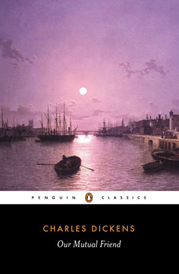Charles Dickens’ novels appeared in many forms even while he was alive: from their original serialization to a variety of new editions throughout his life. But their final form came not through a reading experience but through a performance from the Inimitable himself. These performances, which were called Public Readings, were enormously popular; they were essentially the first blockbusters, long before Jaws and Star Wars popularized the phrase and experience. Dickens performed these readings with a special script, called a Prompt Copy, which was an edition of the novel with sections crossed out and notes written to himself.



The question I aim to explore in this brief article is of what use is this Prompt Copy for the modern reader.
There are a significant number of important pieces of Dickensiana in the Berg Collection at the New York Public Library, but one of the most special is Dickens’ own Prompt Copy of A Christmas Carol. The collection has digitized the entire book and generously made it available for the general public to read online.
 As you can see in this image, Dickens used underlines (under “Scrooge”) to remind himself to emphasize something. He also erased entire paragraphs. The result is a taut reading that flows and emphasizes the transformation of Scrooge’s humanity.
As you can see in this image, Dickens used underlines (under “Scrooge”) to remind himself to emphasize something. He also erased entire paragraphs. The result is a taut reading that flows and emphasizes the transformation of Scrooge’s humanity.
One of the most significant surprises from perusing the Prompt Copy lies not in the deletions but in the changes and additions. Anyone who has spent any time with Dickens’ various periods of composition knows how much he loves to tinker with his punctuation and phrasing. The Prompt Copy is Dickens’ last version he delivered to an audience. Let’s look at one moment where we can see such changes, page 32.
 Dickens has deleted significant portions of the text, and he has also written the note to himself: “run on,” which means to rush on to the next section. You will notice that a lot of what Dickens has cut here are the speaker markers (“said,” “replied,”) because Dickens could mark these with his own speech and body language.
Dickens has deleted significant portions of the text, and he has also written the note to himself: “run on,” which means to rush on to the next section. You will notice that a lot of what Dickens has cut here are the speaker markers (“said,” “replied,”) because Dickens could mark these with his own speech and body language.
What I want to focus on, though, is the bottom paragraph. In the original, Marley’s Ghost says: “‘Oh! Captive, bound, and double-ironed,’ cried the phantom, “not to know that…’” Dickens has cut those original lines and replaced them twice. He first tried “man, cruel man.” For some reason, that did not suffice, so he crossed it out and wrote “blind man, blind man.” At this point, the reader and critic has a role. What is the effect of this change? Why might Dickens have made it? I would offer, as a preliminary suggestion, but one I hope you have alternative theories about, that Dickens loses the irony of Marley, who is actually chained, calling Scrooge “bound, and double-ironed.” Instead Marley twice emphasizes Scrooge’s role as a man--which contrasts to his own phantom state. Thus, we see Dickens slightly shifting the emphasis in the performance to Scrooge’s changed humanity. Further, the twice-emphasized “blind” helps define why Scrooge does not know things. He does not observe them. And so, when over the course of the next three ghosts’ visions he is forced to witness the events around him, he loses his blindness.
I will end simply by sharing one of my favorite moments in the Prompt Copy: when Dickens draws a little hand reminding him to turn the page over. And similarly, may you keep turning the pages of this newsletter.

